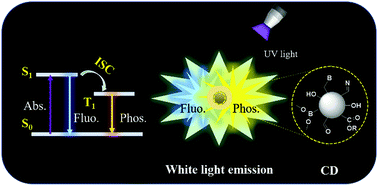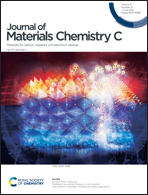Achieving 46% efficient white-light emissive carbon dot-based materials by enhancing phosphorescence for single-component white-light-emitting diodes†
Abstract
White-light-emitting carbon dots (CDs) with fluorescence/phosphorescence dual-emission features are of great importance for single-phase white-light-emitting diodes (WLEDs), but so far rather limited due to weak phosphorescence. Herein, a highly efficient white-light emissive CD-based material is developed by one-step heat treatment of lycorine hydrochloride and boric acid (BA). The prepared CD@BA powders show prominent fluorescence/phosphorescence dual-emission with extraordinarily high overall quantum yield (QY) of 46%, phosphorescence QY of 30% and a broad full width at half maximum over 180 nm. Doping of N and B atoms as well as the strong interaction between CDs and the BA matrix not only effectively prevents aggregation-induced quenching in the solid state, but also greatly promotes phosphorescence emission, leading to the emergence of an ultrabroad-band emission spectrum. Based on the unique dual-emissive performance of CD@BA powders, they are successfully applied to single-component WLEDs. This work provides a new strategy for mass production of efficient white-light emissive CD-based materials, which have promising applications for single-phase WLEDs.



 Please wait while we load your content...
Please wait while we load your content...